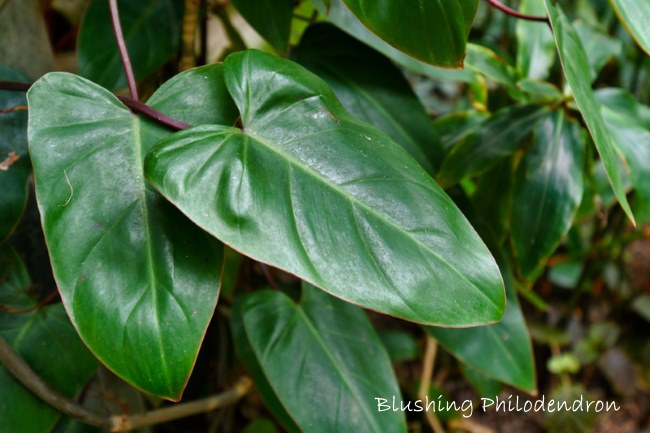How to Grow this Climbing Houseplant
Botanical Name: Philodendron erubescens
Blushing Philodendron sports glossy, heart-shaped leaves along wine-colored stems, making it a standout among houseplants.
It’s a climber. Like many popular indoor plants from this tropical tree-climbing family, this Philodendron is eager to move upward. It’ll need some help from you, but you won’t mind. Give it what it wants and you’ll enjoy your blushing houseplant for many years.
 Red-tinged glossy foliage make ‘Red Emerald’ a favorite houseplant. ©Monikabaumbach
Red-tinged glossy foliage make ‘Red Emerald’ a favorite houseplant. ©MonikabaumbachGet to Know Blushing Philodendron
Elongated heart-shaped leaves will reach about 10-inches (25 cm) long. Glossy and leathery, they often emerge reddish, turning green as they mature. Some hybrids maintain a red or coppery blush underneath.
Although mostly hidden by abundant foliage, the vivid red stems are attention-grabbing. You can show them off by putting a young plant in a hanging basket, allowing the leaf-studded stems to cascade.
Eventually, you’ll want to let Blushing Philodendron climb, as it does in its native South American jungle habitat.
Philodendron erubescens is a robust tree climber in the wild, so you’ll need to give it something to climb indoors. And it’ll need some help from you to start the climb. Don’t worry, it’s easy to do.
A moss stick works wonderfully to support those eager-to-climb stems. It’s a good idea to moisten the moss stick first, to make it easier to pin, and to provide moisture to the aerial roots. Use U-shaped pins (available from a craft store) to hold the stems in place. The plant’s aerial roots will readily sink in, grabbing on to the moss stick. Adjust the pins as needed to train the stems as they grow.
Philodendron Erubescens Varieties
Beautiful hybrids have been developed, offering some captivating options. Choose your favorite — they’re all easy to grow.
- ‘Red Emerald’ sports glossy leaves emerging red then turning to green, and red-wine colored stems
- ‘Burgundy’ has a red blush on its green leaves with burgundy undersides and stems
- ‘Pink Princess’ is a newer cultivar splashed with bright pink
Blushing Philodendron Problems, Solutions and How-tos
Yellow leaves are often a symptom of over-watering. Although, cold drafts from entryways can also cause leaves to quickly turn yellow.
Watch for pests. This vigorous, climbing Philodendron seems to shrug off pests, but keep an eye out for a couple. Aphids are soft-bodied insects. They suck plant juices from the stems and undersides of leaves, excreting honeydew — a sticky substance that may attract ants. Wet, peaty potting mixes attract fungus gnats. They’re not as harmful to plants, but they multiply quickly, then move on to other indoor plants. Not easy to spot, fungus gnats look like tiny, black flies, but tend to crawl or hop above the potting mix. Isolate any infested houseplant and treat it right away.
Keep leaves dust-free. Gently wipe off each leaf with a soft, damp cloth. Cleaning foliage not only makes those glossy leaves shine, it helps them to take in the light they need through photosynthesis. Need another reason to clean your houseplants? It prevents pests from taking up residence.
Wondering when to repot? Spring or early summer is the best time, when plants are beginning their most vigorous time of growth. If roots have filled the pot or are growing out of the drainage holes, it’s definitely time to pot up. Use a large, heavy container to prevent this climbing houseplant from getting top-heavy. This is a good time to insert a moss pole or other support in the pot, if you haven’t already. Here are the steps to repotting house plants.
Blushing Philodendron Care Tips
Origin: Colombia
Height: Climbs to 6 ft (1.8 m) or more
Light: Bright, indirect sunlight will help to grow plenty of large leaves that maintain their color. Small leaves or long spaces between leaves show that the plant is not getting enough light. Move your philodendron plant to a brighter location, but not into direct sun which can scorch its leaves. Don’t have a sunny spot? Blushing Philodendron thrives under artificial grow lights.
Water: Water plant thoroughly, then allow the top 1-inch (2.5 cm) of soil to dry out before watering again. Water less in winter, when growth is slow. Over-watering may cause leaves to turn yellow. Remember to always use room-temperature water for your tropical houseplants because cold water is a shock to them.
Humidity: Aim to maintain 45% relative humidity or higher. Indoor air can become extremely dry in winter without our noticing it. It’s a good idea to use a humidity monitor near your tropical plants, rather than guess. Use a cool-mist room humidifier to boost humidity for your tropical houseplants and they’ll feel right at home. Dry, brown patches and brown leaf tips are a symptom of dry air.
Temperature: Average to warm (65-80°F/18-27°C). Keep this South American native warm year-round. It will tolerate a minimum of 60°F/16°C in winter. Don’t expose your houseplants to cold blasts from an entryway or set them near a heat/AC vent.
Soil: Peat moss-based potting mix with added perlite for fast drainage. African violet potting mix is ideal.
Fertilizer: Feed once a month spring and summer with a balanced water-soluble fertilizer. Stop fertilizing in fall and winter, when growth is slow.
Propagation: Take 3-4 in/7-10 cm-long stem tip cuttings in spring or early summer. Cut just below a leaf node (the place where the leaf is attached to the stem). Nodes contain cells that will develop new roots. Insert stem cuttings in lightly moist potting mix.




